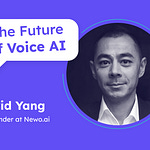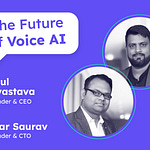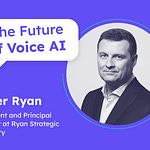In the Future of Voice AI series of interviews, I ask three questions to my guests:
- What problems do you currently see in Enterprise Voice AI?
- How does your company solve these problems?
- What solutions do you envision in the next 5 years?This episode’s guest is Ruma Nair, Principal Product Manager for AI and Customer Engagement at Twilio.
Ruma Nair is a Principal Product Manager at Twilio, leading AI-driven innovation on Twilio Flex, the company’s programmable contact center platform. She specializes in building scalable generative and predictive AI solutions that solve both current and emerging user pain points. With deep expertise in product strategy, discovery, and user behavior analysis, Ruma blends data, customer insight, and technical collaboration to deliver impactful product experiences.
Recap Video
Takeaways
Ruma leads AI product development for Twilio Flex, focusing on tools like Agent Copilot that improve agent onboarding, efficiency, and real-time support.
AI that doesn’t make agents faster, smarter, and more human in real time is already obsolete.
Agent onboarding takes 7–8 months, but many agents leave before that, making AI a critical tool for speeding up training and ensuring consistency.
Agent onboarding can take 7–8 months so your best bet is AI that cuts onboarding time as close to zero as possible.
Contact centers that don't automate after-call work are wasting their best chance to turn customer conversations into business strategy.
Real-time agent assist is the new frontier—it's the difference between good agents and great ones.
Static FAQs are dead; the future is live, contextual copilots that think alongside your agents mid-conversation.
Cutting onboarding time by 40–50% isn’t a nice-to-have—it’s the only way BPOs and contact centers survive today’s churn rates.
Real success in CX isn't just faster training—it's balancing speed with customer sentiment so NPS and CSAT don’t collapse.
Measuring customer sentiment only at the start of a call is a mistake—outcome sentiment at the end is what actually matters.
Real-time agent assist needs to be invisible and perfectly timed—bad UX will get shut off faster than you can deploy it.
Twilio's modular approach isn't just engineering pride—flexible AI platforms will beat one-size-fits-all CCaaS every time.
The biggest gap in CX tech isn’t features—it’s connecting the dots between great point solutions.
Most buyers aren’t confused by AI—they’re paralyzed by choice and burned out by failed pilots.
Jumping from shiny tool to shiny tool without a clear North Star is why so many AI initiatives die on the vine.
AI isn’t always the answer—sometimes better UX beats any model.
In this market, the biggest risk is not building fast—it’s building on the wrong architecture.
Betting on a single AI model vendor is a trap—future-proofing means staying model-agnostic and ready to swap.
If you don't involve legal, procurement, and security from day one, your favorite AI pilot is probably already dead.
The graveyard of AI projects is full of great POCs that never survived the security and compliance gauntlet.
Winning in AI isn’t just running pilots—it's productionizing fast while clearing blockers early.
In the new AI era, flexibility beats first-mover advantage every time.









